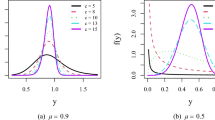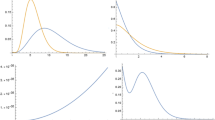Abstract
We propose a new class of state space models for longitudinal discrete response data where the observation equation is specified in an additive form involving both deterministic and random linear predictors. These models allow us to explicitly address the effects of trend, seasonal or other time-varying covariates while preserving the power of state space models in modeling serial dependence in the data. We develop a Markov chain Monte Carlo algorithm to carry out statistical inference for models with binary and binomial responses, in which we invoke de Jong and Shephard’s (Biometrika 82(2):339–350, 1995) simulation smoother to establish an efficient sampling procedure for the state variables. To quantify and control the sensitivity of posteriors on the priors of variance parameters, we add a signal-to-noise ratio type parameter in the specification of these priors. Finally, we illustrate the applicability of the proposed state space mixed models for longitudinal binomial response data in both simulation studies and data examples.
Similar content being viewed by others
References
Akaike H (1973). Information theory and an extension of the maximum likelihood principle. In: Petrov B, Csaki F (eds) 2nd International symposium on information theory. Akademiai Kiado, Budapest
Albert J, Chib S (1993). Bayesian analysis of binary and polychotomous response data. J Amer Stat Assoc 88:669–679
Brockwell PJ, Davis RA (1996) Time series: theory and methods 2nd edn. Springer, Berlin Heidelberg New York
Carlin BP, Polson NG (1992). Monte Carlo Bayesian methods for discrete regression models and categorical time series. Bayesian Stat 4:577–586
Carlin BP, Polson NG, Stoffer DS (1992). A Monte Carlo approach to nonnormal and nonlinear state-space modeling. J Amer Stat Assoc 87:493–500
Carter CK, Kohn R (1994). On Gibbs sampling for state space models. Biometrika 81:541–553
Casella G, George EI (1992). Explaining the Gibbs Sampler. Amer Stat 46:167–174
Chan KS, Ledolter J (1995). Monte Carlo EM estimation for time series models involving observations. J Amer Stat Assoc 90:242–252
Cox DR (1981). Statistical analysis of time series, some recent developments. Scand. J Statist 8:93–115
De Jong P (1991). The diffuse Kalman filter. Ann Stat 2:1073–1083
De Jong P, Shephard N (1995). The simulation smoother for time series models. Biometrika 82(2):339–350
Diggle PJ, Heagerty P, Liang K-Y, Zeger SL (2002). The Analysis of longitudinal data, 2nd edn. Oxford University Press, Oxford
Fahrmeir L (1992). Posterior mode estimation by extended Kalman filtering for multivariate dynamic generalized linear models. J Amer Stat Assoc 87:501–509
Fahrmeir L, Lang S (2001a) Bayesian inference for generalized additive mixed models based on Markov random field priors. Appl Stat 50:201–220
Fahrmeir L, Lang S (2001b) Bayesian semiparametric regression analysis of multicategorical time-space data. Ann Inst Stat Math 53:11–30
Frühwirth-Schnatter S (1994) Data augmentation and dynamic linear models. J Time Ser Anal 15:183–202
Gamerman D (1997) Markov chain Monte Carlo: Stochastic simulation for bayesian inference. Chapman and Hall/CRC, New York
Gamerman D (1998) Markov chain Monte Carlo for dynamic generalized linear models. Biometrika 85:215–227
Gilks WR, Richardson S, Spiegelhalter DJ (1996) Markov Chain Monte Carlo in Practice. Chapman and Hall New York
Jørgensen B, Lundbye-Christensen S, Song P.X.-K, Sun L (1999) A state-space models for multivariate longitudinal count data. Biometrika 86:169–181
Kitagawa G (1987) Non-Gaussian state-space modelling of non-stationary time series (with comments). J Amer Stat Assoc 82:1032–1063
Lee PM (1997) Bayesian statistics : an introduction. Arnold, London
Liu JS (2001) Monte Carlo strategies in scientific computing. Springer, Berlin Heidelberg New York
McCullagh P, Nelder JA (1989) Generalized linear models 2nd edn. Chapman and Hall, London
Pitt MK, Shephard N (1999) Analytic convergence rates and parameterization issues for the Gibbs sampler applied to state space models. J Time Ser Anal 20:63–85
Robert CP (1995) Simulation of truncated normal variables. Stat Comput 5:121–125
Robert CP, Casella G (2004) Monte Carlo statistical methods. Springer, Berlin Heidelberg New York
Schotman PC (1994) Priors for the AR(1) model: parametrisation issues and time series considerations. Economet Theory 10:579–595
Song PX-K (2000) Monte Carlo Kalman filter and smoothing for multivariate discrete state space models. Cand J Stat 28:641–652
Spiegelhalter DJ, Best NG, Carlin BP, van der Linde A(2002) Bayesian measures of model complexity and fit. J. Roy. Stat. Soc. B, 64:583–639
Stoffer DS, Scher MS, Richardson GA, Day NL, Coble PA (1988). A Walsh-Fourier analysis of the effects of moderate maternal alcohol consumption on neonatal sleep-state cycling. J Amer Stat Assoc 83:954–963
Sun D, Tsutakawa RK, He Z (2001) Propriety of posteriors with improper priors in hierarchical linear mixed models. Stat Sin 11:77–95
Tanner MA, Wong WH (1987) The calculation of posterior distributions by data augmentation. J Amer Stat Assoc 82:528–540
Zeger SL (1988) A regression model for time series of counts. Biometrika 75:621–629
Author information
Authors and Affiliations
Corresponding author
Rights and permissions
About this article
Cite this article
Czado, C., Song, P.X.K. State space mixed models for longitudinal observations with binary and binomial responses. Stat Papers 49, 691–714 (2008). https://doi.org/10.1007/s00362-006-0039-y
Received:
Accepted:
Published:
Issue Date:
DOI: https://doi.org/10.1007/s00362-006-0039-y




